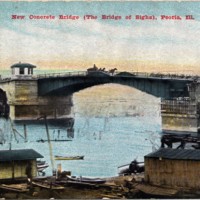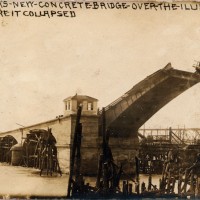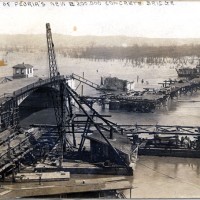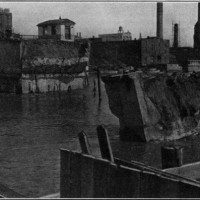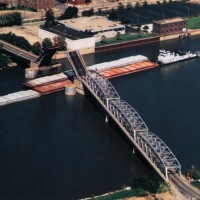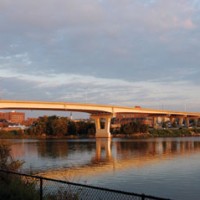Spanning History: The Bridges of Central Illinois
- Details
- Published on Tuesday, 01 January 2013 16:45
- Written by Dr. Peter Couri
Civic pride was high on April 11, 1909. Peoria’s massive new reinforced concrete arch bridge over the Illinois River was being dedicated. It took three years to construct at a cost of $222,088.
The old 1848 wooden bridge, nicknamed “Old Tooth Picks” for its dilapidated and frightening condition, had two sections that had been swept away in a flood. A new bridge was a necessity.
A few weeks later, the night was dark and clear. It was May 1, 1909 at 5:50 a.m. The Illinois River was flowing high, quiet and black. Jim Finley, the night watchman on Peoria’s new concrete bridge, and his partner reported very light traffic that night, both horse and boat.
Suddenly there was a deafening rumbling noise, as if something had hit the center pier of the bridge. Both rushed to the door of the watch tower.
Jim Finley wrote, “As we stepped out, we were just in time to see the first arch from the drawbridge on the south side of the big channel pier rise into the air and crash into the river. There was a creaking and splintering sound of steel, as the ribs of the arch snapped off like matchwood. The arch raised a fearful height into the air and then toppled over. One after another of the arches took the same course, just like cards standing on end and pushed over.”
At the time of the accident, there was no traffic on the bridge and luckily no casualties.
The new bridge was built with five concrete-and-steel arches with one rolling lift span to allow boat traffic to pass. The total length was 1,124 feet. The roadway was 25 feet in width with two 5-foot-wide sidewalks on either side. The five arches supported six spans of 125 feet with longitudinal arch ribs spaced with transverse bars tightly woven in them.
Molded pedestals, parapets, and hand-railings decorated the bridge with Victorian ornaments.
It now lay at the bottom of the Illinois River.
Government engineers reported on the accident and speculated why the bridge fell into the river. They deduced that the catastrophe was a culmination of a long series of mishaps and blunders.
They concluded that as early as 1908, engineers noticed that piers three and four where not placed on sound bedrock and had settled into the river floor by 10 inches in a couple months. Excavations to remedy the settling caused cracks to appear in the walls of the spans. As the city was side-excavating to support the cracking walls, the Illinois River began flooding and stopped the work.
With the foundations deeply undermined, the force of the river current was too much for the lateral support system, a recipe for disaster.
The contractors who built the bridge, Marsh Bridge Company, immediately declared bankruptcy and left the city of Peoria hanging. It took three years to clean up the mess before the new contractors, The Milwaukee Bridge Company, could start a new bridge in January of 1912.
The Franklin Street Bridge
Crowds assembled once again (probably with fingers crossed) in April of 1913 to dedicate the new Franklin Street Bridge. Mayor Woodruff rode in a Peoria-built Glide Automobile with 87-year-old Jacob Koch, who had watched “Old Tooth Picks” being built in 1848 on the same site.
The Franklin Street Bridge was a steel truss bridge with a bascule to allow boat traffic to pass. Though it lasted 80 years, the bridge was always frightening to pass over because it had a two-lane deck that was too narrow. It also had a bend in the center that was not curved and was difficult to maneuver.
As boats approached the bridge, the alignment was off center and it was difficult to judge the clearance. There were many accidents.
The Bob Michel Bridge
In 1993, a new steel girder bridge was opened. With four lanes and a length of 2,365 feet, rising 63 feet above the water, Peoria’s vehicle and boat woes ended.
This bridge replaced the Franklin Street Bridge.
The bridge was named after Peoria High and Bradley University graduate Robert Michel. He was a decorated World War II veteran who served as our United States Congressman from 1956 to 1995, serving as Congressional Minority Leader since 1981.
The modern expansive bridge span is a fitting tribute to one of America’s greatest mediators and patriots.
Connecting downtown Peoria with the busiest retail area of East Peoria as well as Caterpillar Inc.’s top manufacturing facilities, the Bob Michel Bridge has a lot of traffic every day.















































